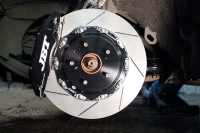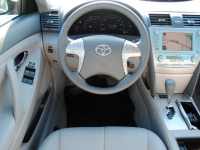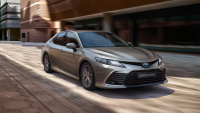Description of the Toyota Camry 2008
Cars of the sample year 2008 have not undergone external changes compared to the technique of previous years of assembly. Concern Toyota did not seek to constantly make innovations in the design of nodes (unlike, for example, the German Volkswagen).
As complaints from customers were received, new units were developed and implemented during the restyling in 2009.
Design and appearance
The design of the car matched the original look of the XV40 generation. The front headlights had lenses with elongated downward inner corners. Halogen bulbs were base, but there was a model with xenon bulbs and water jet cleaning system.
 The front bumper went up to the edge of the hood.
The front bumper went up to the edge of the hood.
Windows were provided for installation of fog lights. The windshield stood at a steeper angle, providing improved aerodynamics and reduced noise at high speeds.
Advantages
The positive sides of the car:
high reliability and liquidity;
unpretentiousness in operation;
roomy interior;
good dynamics;
rich equipment.
Car Specifications
Sedan Camry release of 2008 had a streamlined body with an aerodynamic drag coefficient of 0.28 units. The car is equipped with front-wheel drive (in the territory of EU there are single examples of cars with all-wheel drive, imported by owners from Japan).
The design of the undercarriage retained space subframes of closed type, made of a steel profile. They are used to mount arms and steering, providing increased rigidity.
The vacuum booster braking system had two diagonal circuits operating independently. If one of the lines broke down, the driver could stop the car with the remaining serviceable circuit.
In accordance with international safety requirements the fuel tank was located inside the wheelbase. The tank held 70 liters of gasoline, and was fed by an electric pump through a separate filter. The luggage compartment had a capacity of 504 liters (reduced to 468 liters when equipped with electric rear seat drive). Basic parameters
Basic parameters
Machine specifications (data are for the version with a 2GR engine):
maximum speed of 230 km/h;
acceleration time from a place up to 100 km/h - about 7.4 seconds;
cabin capacity - 5 people;
turning radius (minimum) - 5,5 m;
curb weight - 1540 kg;
load weight - up to 510 kg;
allowable weight of the vehicle - 2050 liters.
Dimensions
Vehicle dimensions:
base - 2775 mm;
track width in the front - 1575 mm;
track width in the rear - 1565 mm;
Overhang length in front and behind - 955 and 1085 mm;
ground clearance - 160 mm;
Body width - 1820 mm;
car length - 4815 mm;
height - 1480 mm.
Engine
 Two 2AZ-FE and 2GR-FE engines with dual injection and exhaust aftertreatment were available.
Two 2AZ-FE and 2GR-FE engines with dual injection and exhaust aftertreatment were available.
The base model was a four-cylinder 2AZ, developing 167 hp at a crank speed of 6000 rpm. The torque was 163 lb-ft at 4,000 rpm. It had a VVT-i phase control and a 16-valve head with a pair of chain-driven camshafts.
For the Luxe model, the 2GR was offered with a V-shaped aluminum block with a 60° camber. The crankcase body had cast-iron liners with channels between adjacent cylinder walls for antifreeze circulation.
The power unit had 12-valve heads with two camshafts. VVT-i variable valve timing was incorporated, and it had a peak output of 277 hp at 6,200 rpm.
The displacement was increased to 3.5 liters (2AZ had 2.4 liters of displacement) to give 346 N*m of torque at 4,700 rpm.
Security System
 Basic safety systems included:
Basic safety systems included:
airbags in the instrument panel, front seat backs, and roof pillars;
diagonal split brakes with ABS unit and electronic pad force distributor;
inertial seat belts (pyrotechnic tensioning devices are provided in the front);
head restraints with cervical spine protection against injuries;
ESP system of trajectory stabilization;
power bars in the doors and alloy steel inserts to protect against side-impact injuries;
ultrasonic parking sensors in the bumpers;
anti-skidding system for the drive wheels.
Fog lights in the front bumper were absent on the base version, some owners installed the elements at the dealer or with their own hands.
Under the rear window, there was an auxiliary brake light by default. Some versions had light and rain sensors, which automatically controlled exterior lighting and windshield wipers. The rear couch had Isofix locks for installing a child seat.
Conveniences
Options for driver and passenger comfort:
hydraulic power steering;
automatic rear-view mirror with automatic dimming;
adjustable steering column;
sun visors with make-up mirrors;
immobilizer with chip for identification located in the ignition key head;
alarm system with remote control in the key;
electric door locks actuators;
step heated front seats;
electric door side window drives and rearview mirrors;
multidirectional seat adjustment (including lumbar support adjustment);
folding backrest of the rear sofa (60/40 ratio);
armrests in front and rear;
climate control system with automatic temperature control (2 zones);
protective coating on windows;
speed control system;
air ducts for rear ventilation;
Full-value spare wheel on cast disk;
6 loudspeakers mounted in doors and upper part of instrument panel;
electric rear sofa adjustment (only for some of the 3.5-liter engines).
Interior fittings
 Soft-touch plastics are used for the dashboard trim; there is a wide console between the manually or electrically adjustable front seats.
Soft-touch plastics are used for the dashboard trim; there is a wide console between the manually or electrically adjustable front seats.
The analog instrument cluster had an on-board computer screen, standard equipment included a 2 Din multimedia center with a CD player and an automatic climate control system. The base seats had fabric covers, while other versions used artificial leather (black or beige).
Features of operation
Since the cars have mileage of at least 100,000 km, some nodes have exhausted their resource. The owner of a used sedan should perform annual maintenance with diagnostics of the running gear and electronic components.
Motors are adapted to cold climate and can be started at air temperature from -35°C without additional preparation.
Before driving, you should let the engine run for 10-15 minutes to warm up the automatic transmission.
Fuel consumption in different conditions
Before buying a used car, you should take into account that atmospheric engines are not notable for their fuel efficiency. According to factory measurements on the highway car with a 2.4-liter power plant requires 6.7 liters of gasoline, but in normal operating conditions, the parameter does not fall below 7.5 liters.
The model with a V-shaped unit consumes from 8 to 8.5 liters of gasoline in the countryside when driving quietly at speeds up to 110 km/h. When driving in traffic, fuel consumption does not fall below 14 liters, regardless of the displacement.
Possible malfunctions
Common malfunctions:
Deformed or worn brake discs;
Wheel misalignment due to wear and tear on the arm joints;
Increased oil consumption due to worn piston rings or drain plugs;
knocking in steering because of wear of a cardan joint;
traces of corrosion on the damaged paintwork;
jerks when shifting gears due to friction clutch wear;
problems during operation of the automatic transmission with 5 steps due to damage of the control unit;
unstable operation of the 3.5-liter engine due to failure of several ignition coils;
knocking of the camshaft position adjustment mechanism when starting the engine.
Car Disadvantages
Disadvantages of sedans noted by drivers:
low ground clearance;
thin paintwork;
Insufficient feedback on the steering wheel when speeding up;
low quality leather, which bursts after 5-6 years of use;
long overhangs worsen the geometric cross-country ability.


-rear-and-front-view-camera-6.png)

